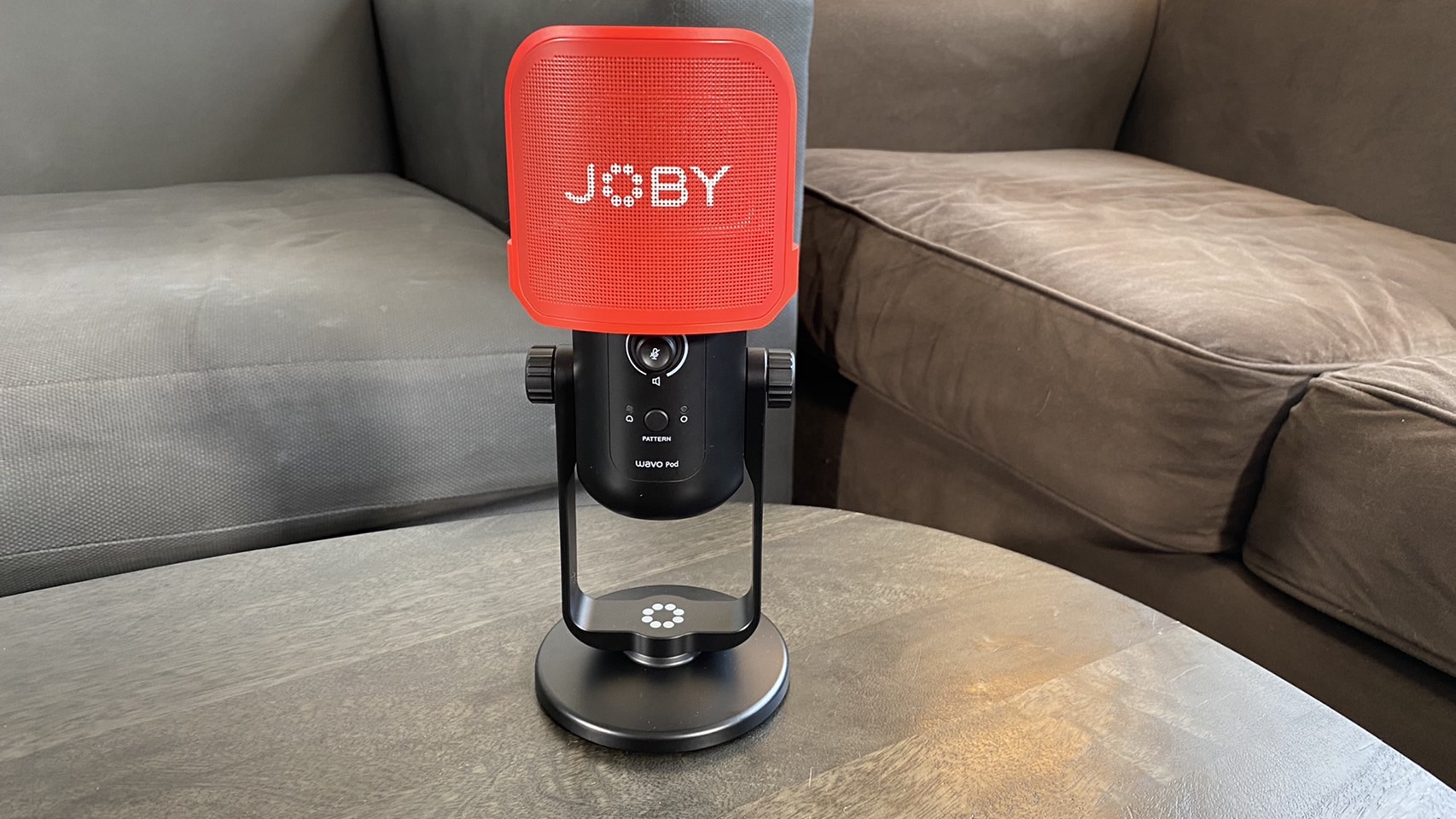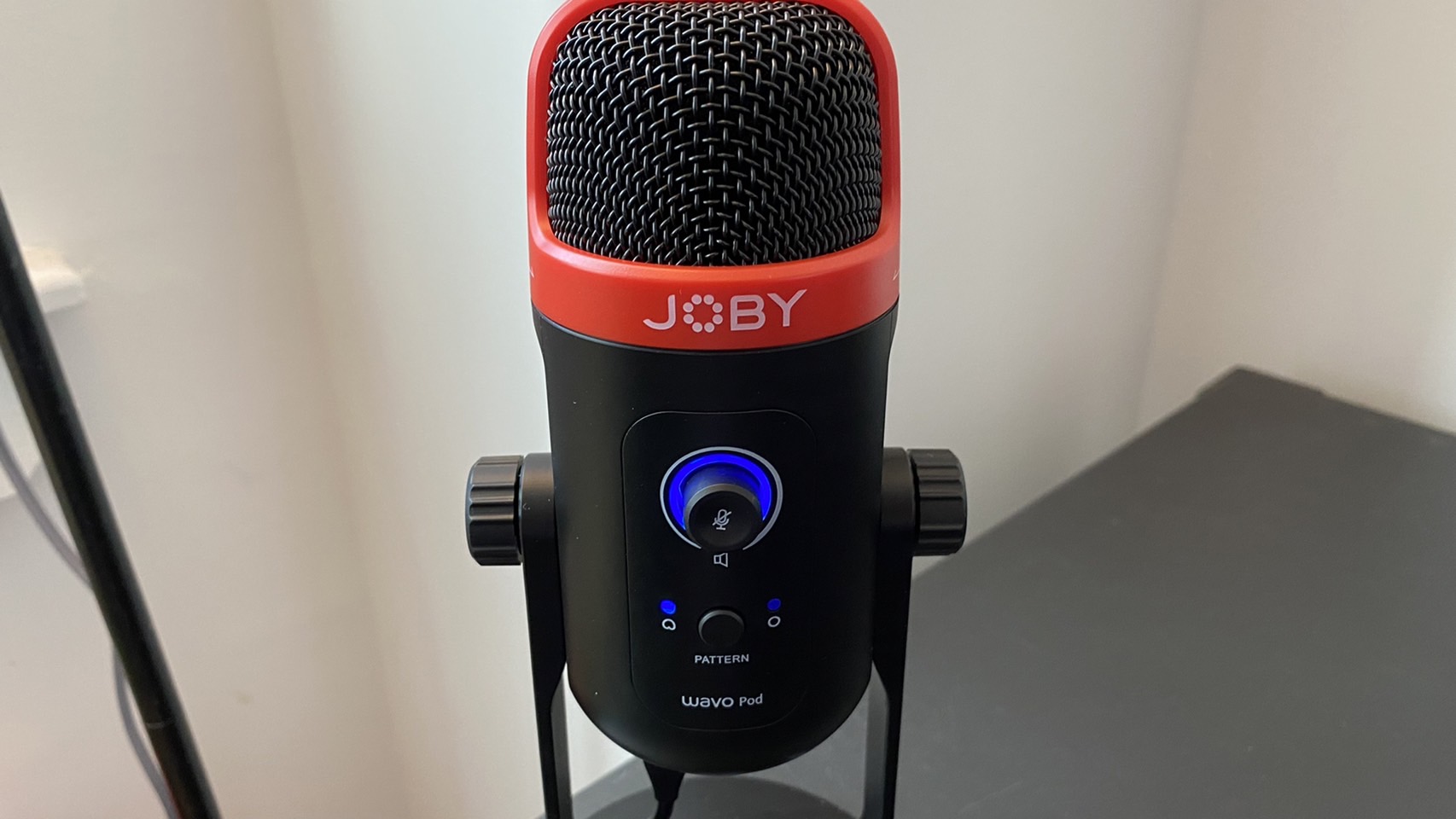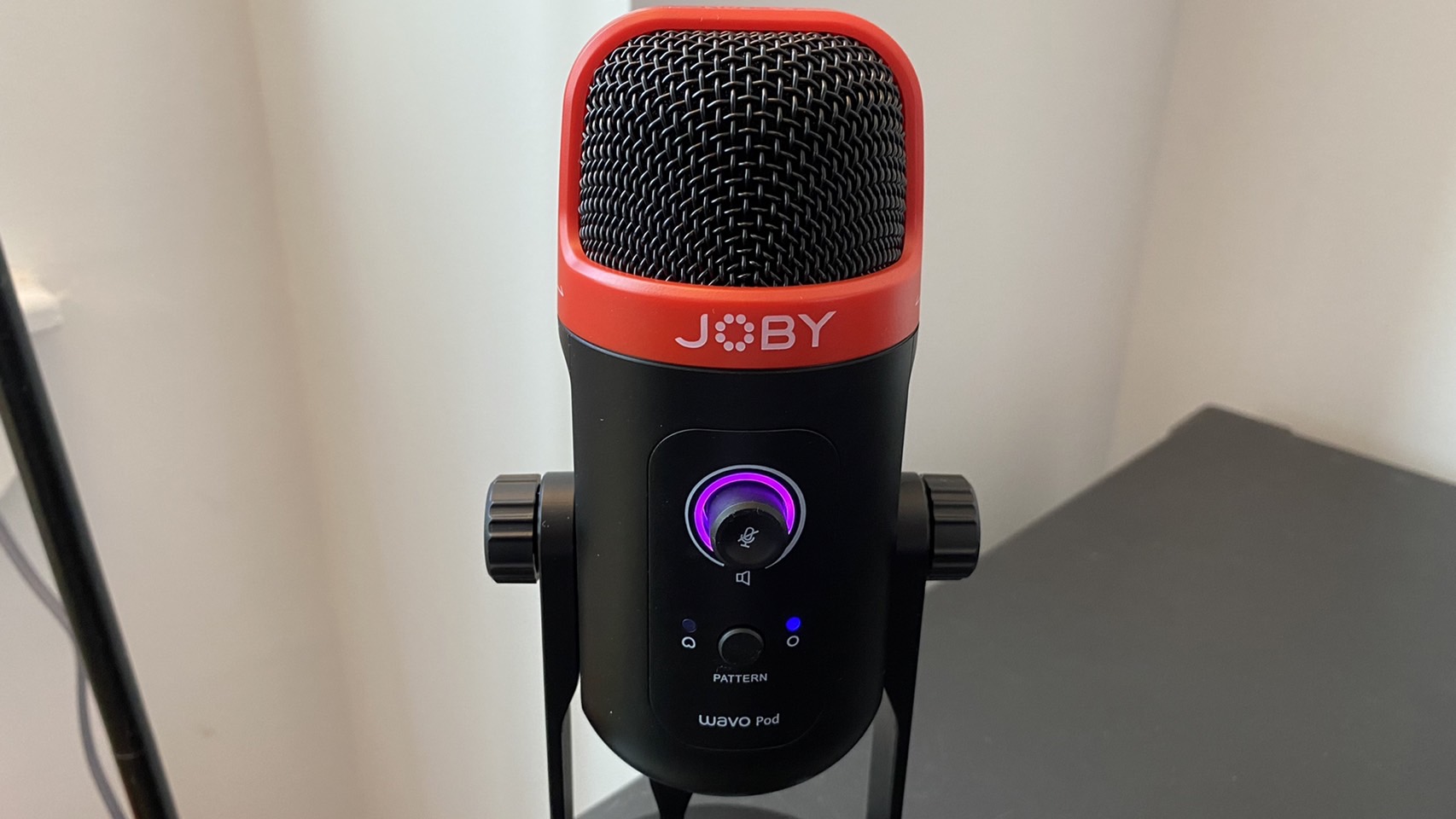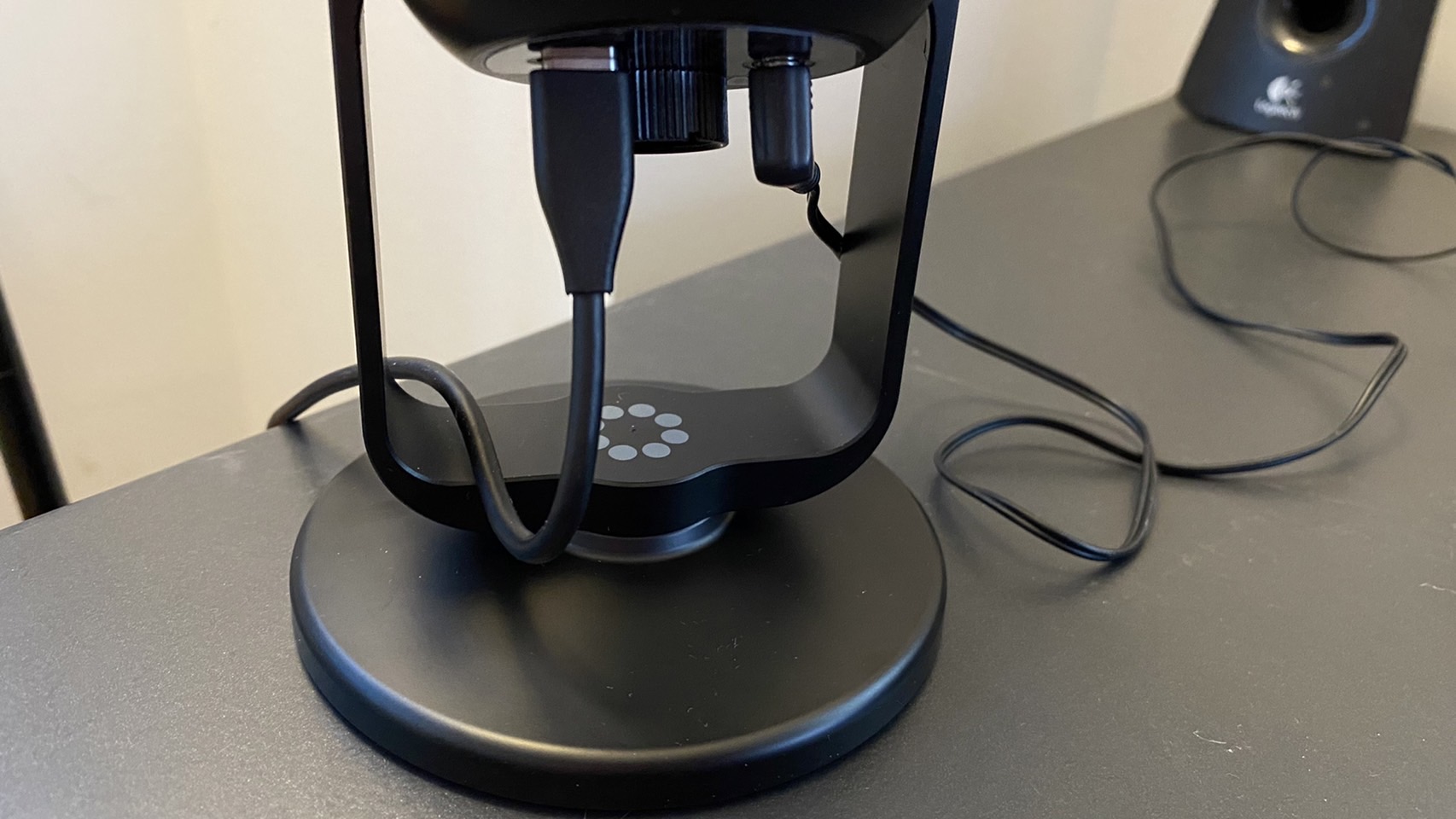Tom's Hardware Verdict
The Joby Wavo Pod has strong audio fidelity and more robust accessory compatibility than other similar microphones in this price range, but its included pop filter comes across as a gimmick.
Pros
- +
+ Compatible with wide range of accessories
- +
+ Strong audio fidelity
- +
+ Looks stylish
- +
+ Convenient size
Cons
- -
Doesn’t live up to claims
- -
Included pop filter is a bust
- -
Cables don’t have enough clearance
Why you can trust Tom's Hardware
Joby is more known for its set of tripods and recording accessories than actual microphones themselves, having invented the popular GorillaPod lineup of camera add-ons for on-the-go vloggers and even professional journalists. But now the company’s looking to make itself known in the microphone space too, with the new Wavo set of microphones.
While many of these are still targeted at on-the-street vloggers, the Joby Wavo Pod instead aims for the home user. This is a $99 USB microphone for streamers and podcasters, which sets itself apart by coming with an included pop filter and compatibility with the GorillaPod and other Joby accessories. We know Joby can do add-ons, but the Wavo Pod proves that it’s got a strong handle on microphones, too. If only the device’s own promises were more realistic, and its own flagship accessory lived up to the quality of the rest of Joby’s brand.
Joby Wavo Pod Specs
| Sample Rate | 48 kHz |
| Bit Rate | 24 bit |
| Frequency Response | 20 Hz - 20 kHz |
| Polar Patterns | Cardioid, Omnidirectional |
| Max SPL | 110dB |
| Sensitivity | -36dB |
| Dimensions | 3.94 x 3.94 x 9.45 inches (10 x 10 x 24cm) |
| Weight | 2.24 pounds (1.02kg) |
| Connectivity | USB-C to USB-C, USB-C to USB-A |
| Price | $99 |
Design of Joby Wavo Pod



Joby’s Wavo Pod is a professional-looking device that strikes a nice balance between a mini microphone like the Razer Seiren V2 X and a larger one like the Neat King Bee II, hitting a maximum of 9.45 inches in height while also boasting some clever lighting features and a built-in pop filter that ships in the box. This mostly works for the device’s look and feel, although its bottom half could use some more clearance for cable management and its combination volume/gain knob could do with some clearer labelling.
Let’s start with the positives. This microphone conveniently places all of its controls on its front side, meaning you won’t need to reach around it to blindly fiddle with settings like pickup patterns or the like. It also cleverly combines its gain, in-headphone monitoring volume and mute functions into a single knob, with a long-press swapping between gain and volume controls and a short tap toggling the mute. A rim light surrounding the knob indicates which mode you’re in, with blue indicating volume adjustment, purple indicating gain adjustment and red meaning that you’re muted. These color choices aren’t just stylish, but are also accessible for colorblind users.



The only other control on the mic is the toggle button, which sits below the knob and swaps your pickup pattern between cardioid and omnidirectional modes. When using a specific pickup pattern, one of two small LEDs will indicate above a graphic of said pattern to show you which one you have selected.
The most noticeable issue with this microphone is the small amount of clearance between the bottom of the microphone itself and the base of its included stand— about 2 inches. L-shaped cable heads (those that bend at a 90 degree angle) should have no problem connecting to the Wavo Pod, but straight cables, including those that come in the box, have just enough room to fit when the mic is fully vertical or tilted backwards. This doesn’t look great on a visual level, and the bend this introduces to your cables could cause them to fray or break over time.
Also, while the multi-use knob does save space, it also makes it hard to know which function you’re adjusting until you memorize the colors associated with each. Ultimately, this is a minor problem, but it does make the microphone more daunting out of the box.
Get Tom's Hardware's best news and in-depth reviews, straight to your inbox.
A bigger issue is that the knob is not notched, so it’s difficult to know how large the adjustments you’re making are. A small microphone icon on the knob helps alleviate this a touch, although that’s mostly there to indicate that pushing the knob in mutes the microphone, and it’s difficult to tell if where it’s pointing relates to volume given that you can spin the knob a full 360 degrees.
On the plus side, the included (and removable) pop filter is small and stylish, although you will have to get used to the Joby logo staring at you if you plan to use it. Both the pop filter and the mic itself also clearly mark which end of the microphone you’ll want to speak into for the best sound with each pickup pattern.
Sound Quality of Joby Wavo Pod
At $99, the Joby Wavo Pod is equivalent in price to a Neat Bumblebee II or a Blue Yeti, which is widely considered one of the best microphones for streaming and gaming As the Blue Yeti is what I had on hand while testing, I opted to use it for my comparisons. While the Blue Yeti is almost 3 inches taller than the Wavo Pod, it has no included pop filter and features two additional pickup patterns that the Wavo Pod does not, I nonetheless experienced almost no difference in fidelity between the two devices.
This is likely due to the similar specs that the two microphones have, including a 20 Hz to 20 kHz Frequency response and a 48 kHz sample rate, which isn’t quite as hi-res as the 96 kHz rate found on more expensive mics but is still the recommended resolution for streaming platforms like Twitch, as these platforms limit bandwidth anyway.
While the Wavo Pod’s specs do differ in minor areas, such as its slightly smaller Max SPL, its quality was still indistinguishable enough from my Blue Yeti that I had to label my audio recordings to tell the difference between ones recorded with the Wavo Pod and ones recorded with the Blue Yeti.
The Blue Yeti is one of the more common hobbyist microphones, despite being somewhat old and disliked by professionals, and makes for a good benchmark for a microphone in the Wavo Pod’s price range. Its standalone design offers higher quality and control than you’ll find in a headset microphone and especially webcam microphones, and it’s able to capture a wider range of vocals than you might be used to if you’ve never used a USB microphone before. You’ll get less echo when speaking from a distance, more sultry tones when speaking up close, better recreation of instruments and of course your own voice and could possibly even include multiple speakers more easily. That the Wavo Pod can match its audio quality is a good sign.
But that doesn’t mean the Wavo Pod is without fault. First off, this microphone makes a big deal of coming with a pop filter, which is supposed to help prevent audio clipping by making plosive and consonant sounds less harsh. That I couldn’t tell the difference between it and the Blue Yeti, unfortunately, reveals this as a gimmick. Don’t get me wrong— pop filters are a legitimate accessory, and professionals swear by them. But this thin plastic clip-on grate is a far cry from a standalone muffler. I easily clipped my audio both with it on and off by shouting harsh “b” sounds, and the same happened when I tried using the filter on my Blue Yeti.
Further, although a more minor complaint, is that there are only two pickup patterns on the Wavo Pod, whereas the Blue Yeti has four. These extra patterns focus on picking up sound from the sides of the microphone, which is a rare use case, but you still have them on the Yeti should the need arise. For instance, they’re especially good for picking up instruments, which tend to reverberate around a room. Meanwhile, the Wavo Pod is only suitable for capturing sound either directly in front of it or all around it.
That omnidirectional pickup pattern is also lacking, however. This isn’t specific to the Wavo Pod, as omnidirectional pickup sounds lackluster on my Blue Yeti as well. The lack of focus lends this pickup pattern to fall prey to echo and background noise, and your audio ends up sounding like it was recorded by an iPhone sitting on a table. Because that’s just the nature of omnidirectional pickup, this wouldn’t be an issue if Joby didn’t advertise recording podcasts with the Wavo Pod’s omnidirectional mode, to the point that it has slots for a second pop filter (which you would need to buy separately) on the back of the microphone.
I can’t think of a podcaster who wouldn’t rather give each recorder their own microphone, or at the very least sit both users in the range of a cardioid or supercardioid pickup pattern. Using an omnidirectional pickup pattern to record a podcast is simply not a reasonable use case for this device.
While the cardioid pickup pattern has much higher quality sound than the omnidirectional one, Joby’s advertising also makes misleading claims here. Joby claims that gamers can place their keyboard and mouse behind the microphone so that the cardioid pickup pattern, which focuses on capturing sound from the front of the mic, won’t pick them up. Unfortunately, on both my Blue Yeti and the Wavo Pod, my keyboard clacking and mouse clicking was easily audible even when using a cardioid pattern. Echo-y, but audible. To avoid picking them up, you’d want to use something like a boom arm.
While these last two issues have more to do with the microphone not living up to Joby’s claims so much as actual audio problems— it sounds as well as you can expect a $100 microphone to sound— there is one more minor annoyance to report. Frequently, when recording with my Blue Yeti, I will rely on its mute button rather than the in-software mute button in my recording suite. This is both due to convenience and the greater assurance that my sound is not coming through on stream.
When I push the Blue Yeti’s mute button, it doesn’t show up on the recording at all, but that’s not the case with the Wavo Pod. Instead, pushing in the Wavo Pod’s combination volume knob/mute toggle creates a noticeable “thump” in your recording, similar to when you unplug a guitar from an amp. While not a problem for the occasional one-off muting, this is a huge red flag for anyone who likes to constantly use their hardware mute button in podcasts and other professional settings, like I do.
Special Features of Job Wavo Pod
The Wavo Pod comes with no included software, and its only features are either physical or relate to the on-mic controls. As stated previously under this review’s design section, you can swap between one of two pickup patterns, as well as adjust gain, in-headphone monitoring volume and mute settings all using the knob and buttons on the front of the mic. Those are the only ways you’ll be able to adjust the sound of the mic itself, but there’s also a few physical features worth addressing with this mic.
I’ve already discussed the included pop filter, which didn’t live up to A/B testing when I used the microphone and comes across more as a gimmick than a serious accessory.
Of more potential use are the Joby Link screw holes on either side of the mic’s stand. As Joby got its start making tripods and various video accessories, these are designed to accommodate those. You can plug in a phone holder, a camera or any number of other add-ons using these slots. Joby didn’t send me any of these accessories to test, but claims that they might be useful for streamers who want an all-in one setup or who want to be able to quickly check chat without moving their head away from their mic.
The bottom of the Wavo Pod also comes with a 3/8” to 5/8” boom arm adapter, so that you can easily plug the microphone into any number of boom arms or tripods, including Joby’s own flagship product, the GorillaPod. Meanwhile, the base stand that the microphone comes with is adjustable, so that you can tilt the microphone back and forth. While not strictly unusual, a tilting stand is not present on other budget mics like the Razer Seiren V2 X.
Bottom Line
The Joby Wavo Pod is a solid budget microphone, easily competing toe-to-toe with the current budget king, the Blue Yeti. Its compatibility with Joby’s ecosystem of accessories should make it an easy choice for any amateur content creators who’ve already got a few Joby tripods hanging around, or even anyone who doesn’t want to bother with a boom arm adapter, as the Wavo Pod comes with one out of the box. And yet, it doesn’t quite live up to all of its promises, especially with its noticeable but largely useless included pop filter.
That’s a surprise, since Joby’s known for its accessories, and not known for audio quality. To see the situation reversed, where quality is strong but the device’s flagship accessory comes off as a gimmick, isn’t encouraging. This is something I’d hope to see fixed in future iterations.
Regardless, if you need an entry-level USB microphone that’s a touch smaller than the Blue Yeti but doesn’t skimp out on fidelity or even customizability, save a few missing niche pickup pattern options, then the Wavo Pod is a strong contender. Just don’t expect the omnidirectional pickup pattern to be podcast worthy or the cardioid pickup patterns to completely eliminate any sound coming from behind the microphone. This is to be expected from a $100 device, but Joby’s marketing would have you believe otherwise.
Michelle Ehrhardt is an editor at Tom's Hardware. She's been following tech since her family got a Gateway running Windows 95, and is now on her third custom-built system. Her work has been published in publications like Paste, The Atlantic, and Kill Screen, just to name a few. She also holds a master's degree in game design from NYU.



